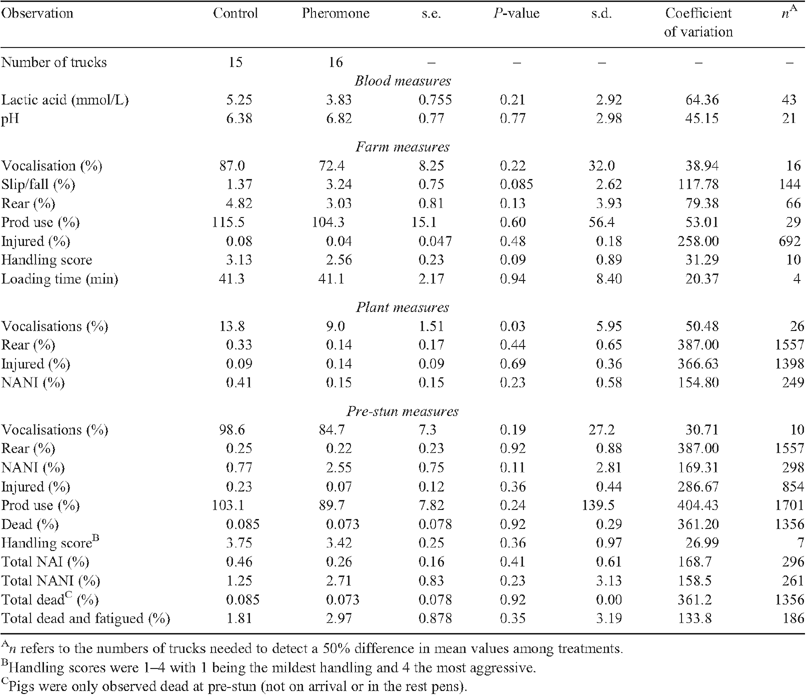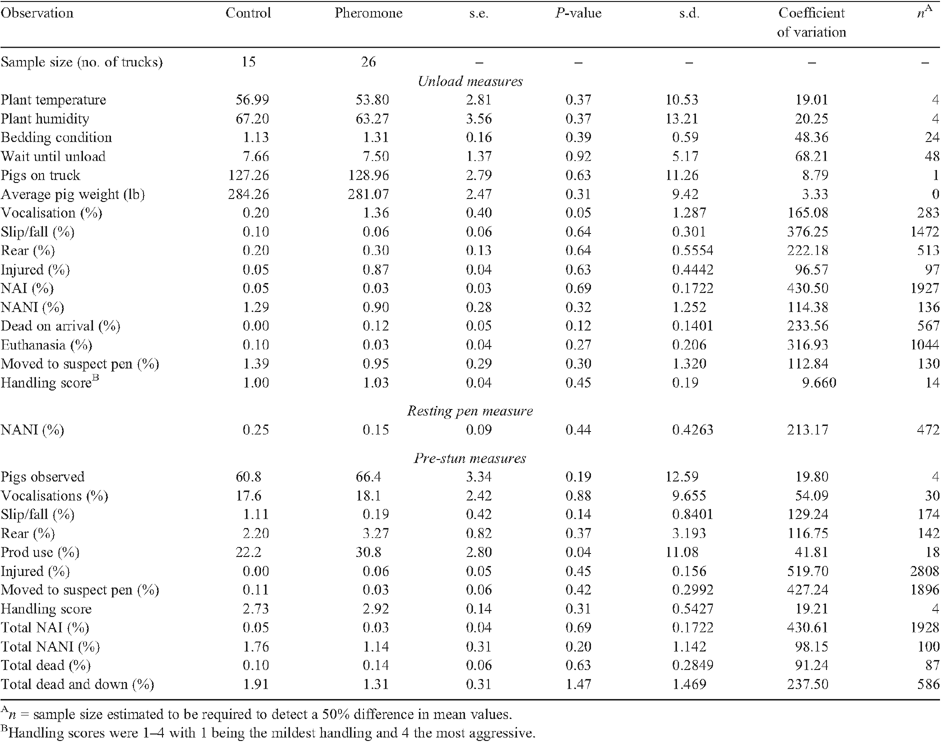Use of a putative maternal pheromone during transport and the effect of trailer temperatures on pig losses and welfare
C. R. G. Lewis A B , N. Krebs A , L. E. Hulbert A and J. J. McGlone A CA Pork Industry Institute, Department of Animal and Food Sciences, Texas Tech University, Lubbock, TX 79409-2141, USA.
B Present address: Animal Genetics and Breeding Unit, University of New England, Armidale, NSW 2351, Australia.
C Corresponding author. Email: john.mcglone@ttu.edu
Animal Production Science 50(10) 916-924 https://doi.org/10.1071/AN09147
Submitted: 9 November 2009 Accepted: 20 August 2010 Published: 21 October 2010
Abstract
The efficacy of a maternal pheromone (MP) to reduce transport stress was evaluated in a field study. In addition, we determined the appropriate field sample sizes for measures of death rate and the proportion of fatigued pigs observed before, during, and after transportation. In the first experiment, semi-truck trailers were randomly treated with 500 mL of MP or isopropyl alcohol as the control (C). Animal handling measures were collected at truck loading, unloading, and from resting pens to the stun area. Blood samples were collected from a sample of transported pigs. In the second experiment, a single truck was used repeatedly for transport to the slaughter plant. The truck and lairage pens were sprayed either with the MP or C, depending on the week (n = 11 weeks). Rate of fatigued pigs coming off the truck was 0.41% for C-treated pigs and 0.15% for MP-treated pigs (P > 0.05). Air temperature recorded in the trailers rose during truck loading and idle time, but levelled off during driving (holding at 1.7°C greater than outside). MP tended to reduce the rate of fatigued pigs (39% although not statistically significant) but it also increased handling difficulty. A power test indicated the sample size needed to detect differences with a statistical significant magnitude (P < 0.05) in future transport studies was 249 trucks (~41 085 pigs).
Introduction
Significant economic losses are experienced from dead and fatigued pigs during and after transportation to the processing plant (Peeters et al. 2004). Non-ambulatory pigs (those that cannot or will not walk) that have no obvious sign of injury are termed ‘NANI’ (Ritter et al. 2009). Fatigued/NANI pigs incur an estimated annual cost of $100 million (Ellis and Ritter 2005) in the USA, and considering the economic and welfare consequences of NANI and dead on arrival (DOA) pigs, interventions are being sought to reduce the cost of transport losses.
An issue of increasing importance to consumers and major meat buyers is animal handling and welfare. The assurance that slaughter stocks are well cared for has become important for production companies and thus has focussed research into this area as a result of the consumer and market forces (Grandin et al. 2003). The welfare concerns associated with fatigued pigs and livestock transportation generally (Pettiford et al. 2008) are a contentious issue not only due to the perceived welfare concerns to the animal but also due to the human–pig interaction that occasionally precedes the condition.
The overall causes of fatigued pigs are elusive and almost certainly multifactorial. Some losses may even be unavoidable with current production processes. To examine new management methodologies, a full audit of animal handling is needed to examine all of the available variables, in the form of a pilot study. This study provided an opportunity to test an intervention strategy for down and fatigued pigs in the form of a maternal pheromone (MP). As pigs are sensitive to pheromones and their use has previously been shown to modify behaviour it was hypothesised that the use of an MP could address some of the novel environment issues associated with transport.
The first objective of this pilot study was to evaluate the efficacy of a synthetic MP applied to either the trailer and/or resting pens on reducing the rate of dead and fatigued pigs during and around the time of transport. The second objective was to determine temperature changes within the trailer during loading, driving, idle and unloading and to examine if there was an interaction with down pigs or pheromone treatment. Finally, the third objective was to determine the sample size needed to detect meaningful treatment differences from the application of pheromone on the rate of fatigued pigs.
Materials and methods
General
These studies were approved by the Institutional Animal Care and Use Committee at Texas Tech University. Pigs came from commercial stock (PIC commercial lines and PIC crossbred lines). Standard commercial trucks with straight decks and side unloading doors were used to transport 165 finishing pigs to slaughter per trip. Normal commercial practices were maintained (e.g. mixing of pens within truck compartments) with the exception of the application of the pheromone. Tractor trailers (truck/trailer) were identical and provided ~88 m2 of total floor space or ~0.53 m2 per pig.
Experiment 1: MP on the truck versus control (C) solution
Animals and housing
The pigs used in this study came from an integrated commercial farm in the Midwestern USA. Pigs were not administered Paylean® (Elanco Animal Health, Indianapolis, IN, USA), a ractopamine product. Before transportation, all of the control and treatment animals were similarly treated with free access to feed and water.
Pheromone application
Before transportation of pigs, 31 trucks [51 feet (15.7 m) long and 8 feet (2.5 m) wide with two decks] were either uniformly sprayed with 500 mL of a synthetic MP (n = 15, green in color) called Suilence® (Ceva Santé Animale, Libourne, France) or isopropyl alcohol, the placebo for the synthetic MP (C, n = 16, artificially coloured in green with food dye). The pheromone is a mixture of fatty acids and the formula is described in detail on the patent, the pheromone is present at 20% concentration in alcohol. All treatments were anonymised with same colour fluids labelled A or B to avoid bias. Treatments were applied uniformly on the floors, bedding and walls of the truck trailers with a spray bottle. The trailers were then loaded from adjacent finishing barns within the same site to avoid cross contamination of treatments. Usually, trucks assigned to a treatment were used several consecutive times and were only washed before being used in the other treatment (as thorough washing with detergent and water followed by industry standard drying time was expected to remove all traces of the pheromone). The trucks used in the study were randomly assigned to receive either the C or the MP treatment; and five to six trucks per site were tested each day. Farm staff was not made aware of the treatment identity during each loading event. Continual application of the pheromone was not required as has been previously been shown that the product can persist for 24 h in a stable environment. Also stimulation of the olfactory bulb was more important than prolonged exposure as pheromones have effects well beyond the olfactory perception (e.g. sexual pheromones can stimulate the onset of oestrus).
Data collection
Data were collected on audit forms by researchers located at the farm (for loading) and at the processing plant (for unloading and at the pre-stun area) located 40 miles (65 km) away, a journey that lasted 45–60 min. The measurements collected on the audit forms are presented in Table 1.
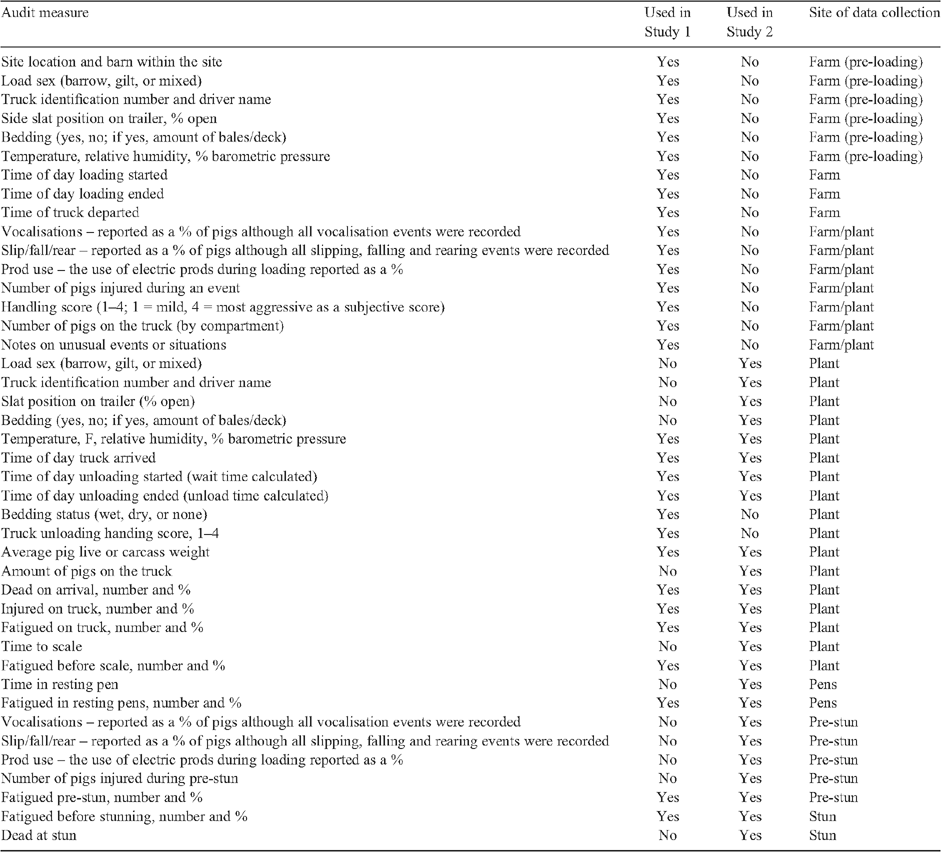
|
Meat quality measures (muscle pH and Japanese colour score, see Tan et al. 2000) were recorded at the packing plant on a random sample of three to five pigs per truck (from the M. longissimus dorsi) as a preliminary examination of possible effects. As the truck/trailer was the experimental unit, an average was recorded for each truck/trailer for all measures. Blood pH was recorded using a pH meter (Accumet AB15, Fisher Scientific, Pittsburgh, PA, USA). Lactic acid blood concentrations were determined from blood collected at the plant at exsanguinations with heparin used as the anticoagulant. Plasma cortisol levels were determined from plasma from heparinised tubes using a Coat-a-Count cortisol kit (Diagnostic Products, Los Angeles, CA, USA) with the minimal detectable cortisol concentration of 2 ng/mL; intra assay coefficient of variation was less than 10%.
Prior to transportation, trucks were fitted with temperature and humidity recording devices (HOBO model H8-003-02, Onset Computer Applications, Bourne, MA, USA). These were fitted to the truck on the bottom deck next to the side unloading door, to record throughout haulage until unloading. The recordings were every 12 s with the accuracy of temperature and relative humidity (RH) measurement ± 0.41°C and 5%, respectively. All HOBO were calibrated and validated against a thermometer and each other before the study.
Outside air temperature and RH were recorded as the trucks were travelling with the HOBO being located away from locations where water, engine heat, or radiant gain could bias measurements; this location was the rear unloading door out of direct sunlight. An external measure was a necessity as all trucks were naturally ventilated using vents and these vents were fixed at the open position during this study. The relationships (correlations and regressions) between the outside air temperature and the temperature inside the truck were calculated during transportation (while trucks were moving) and the time periods when the trucks were stationary. The location of the HOBO within the truck was selected after the first truck was fitted with numerous recorders to ascertain the best location. This was done as previous research (J. J. McGlone and C. R. G. Lewis, unpubl. data) demonstrated that there was substantial variation between microclimates within the truck. The location selected for the internal HOBO was on the bottom deck of the trailer above the side exit door, as this location provided the best estimate of the average climate of the truck.
Statistical analyses
The audit measures were analysed using SAS General Linear Models (Proc GLM; SAS, Cary, NC, USA). The model included the dependent variables listed in the audit measures list and fixed effect of treatment (MP versus C) and covariates of temperature, humidity, travel time, pig vocalisations at loading and unloading, electric prod use and handling scores. For the climate data relationships were assessed by examining correlations and fitting regression lines to data. A total of 31 trucks were assessed.
Experiment 2: MP on the truck and pens versus C
Animals housing and treatments
The commercial stock pigs used for this study were from a USA Midwestern farm (although different to that of the farm used in Experiment 1). The 41 trucks were assigned one of two treatments: (1) C (n = 15), standard transportation without any pheromone or (2) where 500 mL MP (n = 26) was sprayed evenly on the top and bottom decks of the trailer and 500 mL of the MP sprayed in the lairage pens. The treatments were assigned as either C- or MP-treated pigs and were transported every other week (for 11 weeks). The truck driver and plant staff were trained to apply the MP and record the audit information. The same truck drivers and plant staff were used during the study. Measurement parameters were identical to Experiment 1; however, the audits at the farm (loading) were removed (Table 1).
Statistical analyses
The audit measures were analysed using SAS GLM and mixed model procedures. The effects of the model included fixed effect of treatment (MP versus C) and additional models included the covariates temperature, humidity, travel time, pig vocalisations at loading and unloading, electric prod use and handling scores. The truck/trailer was the experimental unit – treatments were applied to the entire trailer and so measures were averaged by trailer in data analyses. Three to five pigs per truck/trailer were sampled for blood and meat measures. All pigs were measured for handling scores and audit data collection, but again, data were averaged per experimental unit (truck/trailer).
Results
Experiment 1: MP on the truck versus C solution
The results of the animal handling audit data and blood analyses are shown in Table 2. Measures that had zero values or no variation were omitted. Meat quality data including Japanese colour scores did not differ (P > 0.05) between treatments (data not shown).
Pigs treated with MP vocalised less (13.8 compared with 9.0) at the plant (P < 0.05) than C-treated pigs. All other measures were not statistically significant (P > 0.05) between treatments. The rate of NANI pigs upon plant arrival had a reduced trend of 75% for MP versus C pigs (P > 0.05 i.e. not significant) based on the reduction in least squares means, but these means were very low compared with average values at that site. The rate of NANI pigs in the pre-stun area (where no treatment was applied) tended to be higher for MP-trailer-treated pigs versus C-treated pigs (Table 2).
Data collected from the temperature and humidity recording devices (23 recordings as the other eight devices failed) showed that the inside air temperature increased linearly during transportation while RH decreased (Fig. 1). Air temperature increased only during the initial time of transit and during unloading. During transport, the temperature remained stable (almost equal to the outside temperature). The temperature rose when the truck was idle and loaded with pigs.
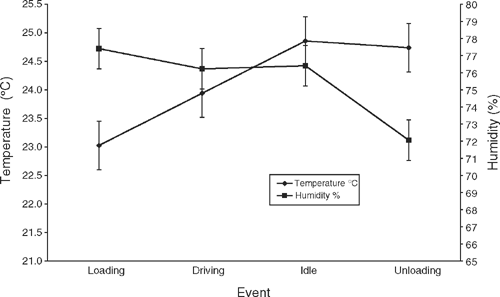
|
Presented in Fig. 2 is temperature and RH data from a typical truck journey. The air temperature in the truck rose during truck loading and then declined as the truck moved. After being on the road 10 min, the air temperature inside the truck was stable at ~22.5°C.
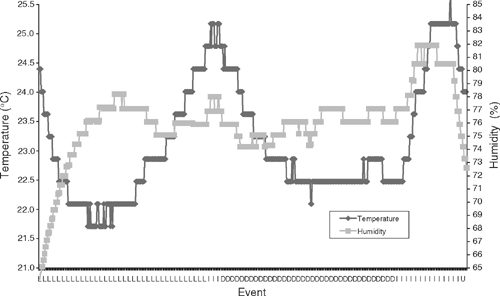
|
Air temperature in the observed trucks rose while the truck was idle (Fig. 3). The rate of increase in temperature averaged ~0.1°C per minute of standing-still time (or ~0.8°C/10 min). During transit, the temperature inside the truck was ~1.8°C warmer than the outside air temperature. Thus, for trucks with this configuration (of slats open etc.), the air temperature rose steadily (starting ~1.7°C above the outside air temperature). Summarised in Tables 3 and 4 are some models that may help producers set limits on the time trucks can stay idle.
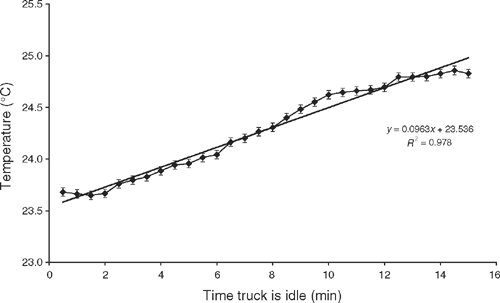
|
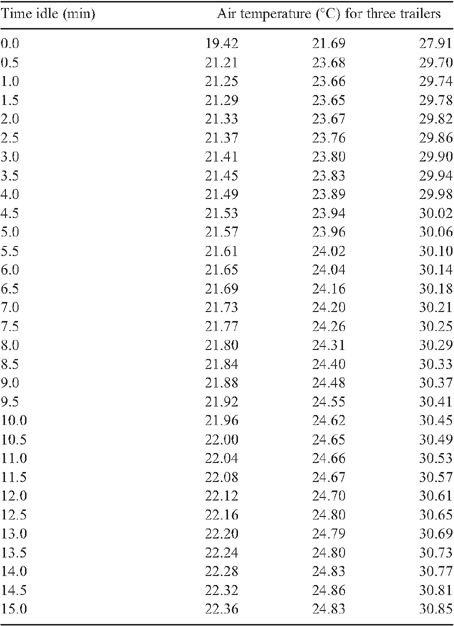
|
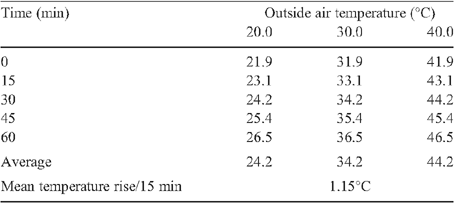
|
Experiment 2: MP on the truck and pens versus C
Pigs exposed to the MP were prodded more during pre-stun (30.8 times compared with 22.2 P < 0.05) and vocalised more during unloading (1.36 vocalisations compared with 0.20 P < 0.05) compared with C-treated pigs, strange considering that this was the opposite case in experiment one (Table 5). The MP may have increased the handling difficulty of the pig (MP-treated pigs were less willing to move than C-treated pigs as shown by increased handling difficulty). However, the rate of overall NANI pigs was reduced by ~39% (P > 0.05) compared with C-treated pigs. Generally, the number of DOA and NANI pigs was low in the audited trucks compared with the farm-truck-plant average.
Discussion
Pigs are macrosmatic animals, i.e. they can detect low concentrations of odours and pheromones using the main and accessory olfactory systems (Halpern 1987). Pheromones can modify the behaviour of pigs. Vieuille-Thomas and Signoret (1992) used pig urine (containing pheromones) to stimulate agonistic behaviour and adverse experience and McGlone (1984) found that urine collected from a dominant nursery pig sprayed in a nursery pen reduced agonistic behaviour among newly weaned nursery pigs. Pheromones may also be a way of communication such as signalling submission or alarm to other pigs. McGlone and Morrow (1988) showed that androstenone, the boar pheromone, reduced aggressive behaviour among newly weaned nursery pigs and further work by Morrow-Tesch and McGlone (1990), McGlone and Anderson (2002) and Pageat and Madec (2002), respectively, showed that MP were attractive to nursing piglets (the MP-directed teat-searching behaviour) and that MP decreased agonistic behaviour, increased feed efficiency and improved weight loss at weaning. It was the reduction in agonistic behaviour and a general observation of the MP calming effect that caused us to hypothesise the putative MP may be useful to reduce stress during transport, mixing, and during exposure to novel environments. Having a natural odour in an otherwise unfamiliar environment may reduce the negative effects of novel environment.
Many factors and interactions need to be evaluated in the transportation and handling experiences for the pig. Some of the important factors and critical time points during the transport experience include: truck loading, the process of transport/driving down the road, space allowance (stocking density), truck unloading, season, temperature, humidity, mixing, journey distance, post-transport penning, pig genetic and environmental interactions, and the type of alley, chutes and devices used to handle pigs (Geers et al. 1994; Grandin 1997; Warriss 1998; Gosalvez et al. 2006; Ritter et al. 2006, 2007; Correa et al. 2008).
Economically viable, humane production and ethical transport techniques are critical because transportation of pigs from the farm site to the slaughter facility is a necessary step in the food chain. It has been documented that stress in general and transport in particular has profoundly negative effects on the physiology of the pig (Peeters et al. 2004; Salak-Johnson and McGlone 2007). McGlone et al. (1993) found that shipping pigs had effects on the immune system, bodyweight, and the hypothalamic-pituitary (stress) axis of the pig. Lewis and McGlone (2007) described the cardiovascular effects of the handling of pigs in different group sizes. Changes in the size of groups of pigs that are handled had a significant impact on cardiovascular rate and ease of handling – when more than seven pigs were moved down an alley at one time, pig heart rates were increased. Having too large of a group size while handling combined with a lack of sufficient feed in the gastrointestinal tract can result in increased numbers of fatigued pigs (Lewis and McGlone 2008). Inappropriate handling methods, vibration during transport, transport time, environmental conditions and the novel environment itself (Lewis et al. 2008) plus a host of other factors contribute to the problem of fatigued pigs during transport.
The main overall objective of this study (i.e. the distillation of the three objectives) was to develop a controlled model of commercial pig transportation (including modelling temperature as possible interactions could exist) to and then to determine the efficacy of MP to impact the rate of fatigued or dead pigs during transport. These studies utilised thousands of pigs but only 31 and 41 truckloads of pigs, respectively, per treatment. High winds and rain during parts of the study might have diluted some of the MP applied. During warm days, the truck sprinklers were activated during loading and may have contributed to the dilution (or even washing away) of the MP from the transport trailer. However, it is likely that the bedding within the truck soaked up some of the MP so its effect would have been perceived despite the environmental challenges presented. The fact that we observed a large percentage improvement (though not statistically significant) in the rate of NANI and behavioural effects may indicate that the MP was having effects that could be confirmed in a larger study.
A further observation was that a low percentage of dead and fatigued pigs were observed among test trucks compared with trucks from other same-farm sites arriving at the processing plant (possibly indicative of experimental bias due to the presence of the researchers). The farm loading crews performed well during the test week while experimenters were present. Truck drivers may have been more careful to alter their driving style, due to the presence of the experimenters and the auditing process. The driving style of the truck driver has been previously shown to affect the physiology of sheep (Cockram et al. 2004).
The effects of the application of MP to empty pens in the processing plant alone should be investigated (the pigs could be exposed to the MP upon arrival at the plant) in further experiments. This application would remove the need to treat trucks in the field and could also improve meat quality as lower stress, muscle pH, and lactic acid can be reduced with improved handling (Hamilton et al. 2004). Hambrecht et al. (2005) applied this idea by examining suboptimal lairage conditions and its effects on meat quality and found that the negative effects of stress (such as reduced water holding capacity) were aggravated in these environments.
Recently Driessen et al. (2008) and coauthors also utilised an MP in a transport simulator. Their results indicated that the application of the MP reduced the minimum, mean and peak heart rates of the pigs as opposed to the C group. These authors then concluded that the use of these olfactory substances may help with the pigs’ ability to cope with transportation stress and thus improve welfare. This recent research corroborates well with our findings as the tendency for reduced incidence of NANI and behavioural effects of pigs could be seen as increased welfare also.
Temperature and humidity were examined as it is currently believed that the microclimate within the truck can affect the welfare of the pig during transportation (Ellis et al. 2005). Indeed, Ritter et al. (2005) found that there was a correlation between environmental conditions during transport and the rate of fatigued pigs. Our results show the relationships between different phases of loading and unloading and suggest guidelines for producers (Tables 3, 4). Indeed, Fig. 3 highlights the increase in temperature of ~0.1°C per minute of time idle (or ~0.8°C/10 min). Our readings from during transit demonstrate that once the truck was moving, the temperature inside the truck was stable (no slope) around 1.8°C warmer than the outside air temperature. A small caveat is that as the heat load upon animal increases thermoregulatory activity (postural changes, panting etc.) result in the animals adding additional heat and water vapour to their immediate thermal environment. This will reduce both sensible and latent heat loss potential and thus induce further heat stress especially during transport. Thus, a linear extrapolation of the temperature data alone may actually underestimate the severity of the stress induced by the recorded dry bulb temperatures. This is still useful field information that can be used for making judgments on trailer side-wall slat configuration or stocking density in different temperatures and environmental conditions.
We used a power test to estimate that the number of trucks needed to detect a difference of 50% (at the P < 0.05 significance level) in the rate of fatigued pigs. Such a study would require 249 trucks. The numbers of trucks needed was very high due to the low average rate of fatigued pigs in this study. If the means were higher (and closer to the industry norm), it is possible that fewer trucks would be needed to detect a meaningful difference.
Transport related problems are a serious economic problem and an important animal welfare concern; efforts should be made to conduct studies on a much larger scale to find effective interventions that will lower the rate of dead, down and fatigued pigs. There may be merit in research into the use of MP as an intervention strategy. This study however did reinforce the idea that the complex interactions between genetic, environmental, and human factors cause significant variation in rates of NANI and DOA pigs. The main causes of this specific industry economic and welfare issue have yet to be fully unravelled.
Acknowledgements
This project was supported and funded by Elanco Animal Health. Pheromone was donated by Ceva Santé Animale. Thanks are due to Elanco field collaborators Mr Perry and Dr Matzat, and also to Mr J. Smith, and Mrs N. Lewis (from Texas Tech) for help in data collection and technical assistance. Finally, thanks should be conveyed to the staff of several Midwestern farms/plants for their help during the fieldwork.
Cockram MS,
Baxter EM,
Smith LA,
Bell S,
Howard CM,
Prescott RJ, Mitchell MA
(2004) Effect of driver behaviour, driving events and road type on the stability and resting behaviour of sheep in transit. Journal of Animal Science 79, 165–176.
[Verified 6 September 2010]
Ellis M,
Ritter M,
Anil L,
Butler D, Curtis S ,
et al
.
(2005) Welfare of finisher pigs during transportation to slaughter. Journal of Animal Science 83(Suppl.), 258–259.
[Verified 6 September 2010]
Halpern M
(1987) The organization and function of the vomeronasal system. Annual Review of Neuroscience 10, 325–362.
| Crossref | GoogleScholarGoogle Scholar |
CAS |
PubMed |

Hambrecht E,
Essien JJ,
Newman DJ,
Smits CHM,
den Hartog LA, Verstegen MWA
(2005) Negative effects of stress immediately before slaughter on meat quality are aggravated by sub-optimal and transport conditions. Journal of Animal Science 83, 440–448.
|
CAS |
PubMed |

Hamilton DN,
Ellis M,
Bertol TM, Miller KD
(2004) Effects of handling intensity and live weight on blood acid-base status in finishing pigs. Journal of Animal Science 82, 2405–2409.
|
CAS |
PubMed |

Lewis CRG, McGlone JJ
(2007) Moving finishing pigs in different group sizes: cardiovascular responses, time, and ease of handling (short communication). Livestock Science 107, 86–90.
| Crossref | GoogleScholarGoogle Scholar |

Lewis CRG, McGlone JJ
(2008) Modelling feeding behaviour, rate of feed passage, and daily feeding cycles, as possible causes of fatigued pigs. Animal 2(4), 600–605.
| Crossref | GoogleScholarGoogle Scholar |

Lewis CRG,
Hulbert LE, McGlone JJ
(2008) Novelty causes elevates heart rate and immune changes in pigs exposed to handling, alleys, and ramps. Livestock Science 116, 338–341.
| Crossref | GoogleScholarGoogle Scholar |

McGlone JJ
(1984) Olfactory cues and pig agonistic behaviour: evidence for a submissive pheromone. Physiology & Behavior 34, 195–198.
| Crossref | GoogleScholarGoogle Scholar |

McGlone JJ, Anderson DL
(2002) Synthetic maternal pheromone stimulates feeding behaviour and weight gain in weaned pigs. Journal of Animal Science 80, 3179–3183.
|
CAS |
PubMed |

McGlone JJ, Morrow JL
(1988) Reduction of pig agonistic behaviour by Androstenone. Journal of Animal Science 66, 880–884.
|
CAS |
PubMed |

McGlone JJ,
Salak JL,
Lumpkin EA,
Nicholson RI,
Gibson M, Norman RL
(1993) Shipping stress and social status effects on pig performance, plasma cortisol, natural killer cell activity, and leukocyte numbers. Journal of Animal Science 71, 888–896.
|
CAS |
PubMed |

Morrow-Tesch JL, McGlone JJ
(1990) Sources of maternal odours and the development of odour preferences in baby pigs. Journal of Animal Science 68, 3563–3571.
|
CAS |
PubMed |

Pageat P, Madec I
(2002) Interest in using pheromones in breeding farms. Comptes rendus de l’Academie d’Agriculture de France 88(4), 47–51.
|
CAS |

Peeters E,
Driessen B,
Steegmans R,
Henot D, Geers R
(2004) Effect of supplemental tryptophan, vitamin E, and a herbal product on responses by pigs to vibration. Journal of Animal Science 82, 2410–2420.
|
CAS |
PubMed |

Pettiford SG,
Ferguson DM,
Lea JM,
Lee C,
Paull DR,
Reed MT,
Hinch GN, Fisher AD
(2008) Effect of loading practices and 6-hour road transport on the physiological responses of yearling cattle. Australian Journal of Experimental Agriculture 48(7), 1028–1033.
| Crossref | GoogleScholarGoogle Scholar |

Ritter MJ,
Ellis M,
Brinkmann J,
Keffaber KK, Wolter BF
(2005) Relationship between transport conditions and the incidence of dead and non-ambulatory finishing pigs at the slaughter plant. Journal of Animal Science 83(Suppl.), 258–259.

Ritter MJ,
Ellis M,
Brinkmann J,
DeDecker JM,
Keffaber KK,
Kocher ME,
Peterson BA,
Schlipf JM, Wolter BF
(2006) Effect of floor space during transport of market-weight pigs on the incidence of transport losses at the packing plant and the relationships between transport conditions and losses. Journal of Animal Science 84, 2856–2864.
| Crossref | GoogleScholarGoogle Scholar |
CAS |
PubMed |

Ritter MJ,
Ellis M,
Bertelsen CR,
Bowman R, Brinkmann J ,
et al
.
(2007) Effects of distance moved during loading and floor space on the trailer during transport on losses of market weight pigs on arrival at the packing plant. Journal of Animal Science 85, 3454–3461.
| Crossref | GoogleScholarGoogle Scholar |
CAS |
PubMed |

Ritter MJ,
Ellis M,
Berry NL,
Curtis SE, Anil L ,
et al
.
(2009) Review: transport losses in market weight pigs: I. A review of definitions, incidence, and economic impact. The Professional Animal Scientist 25, 404–414.

Salak-Johnson JL, McGlone JJ
(2007) Making sense of apparently conflicting data: stress and immunity in swine and cattle. Journal of Animal Science 85(Suppl.), E81–E88.
| Crossref | GoogleScholarGoogle Scholar |
CAS |
PubMed |

Tan FJ,
Morgan MT,
Ludas LI,
Forrest JC, Gerrard DE
(2000) Assessment of fresh pork color with color machine vision. Journal of Animal Science 78, 3078–3085.
|
CAS |
PubMed |

Vieuille-Thomas C, Signoret JP
(1992) Pheromonal transmission of an aversive experience in domestic pig. Journal of Chemical Ecology 18, 1551–1557.
| Crossref | GoogleScholarGoogle Scholar |

Warriss PD
(1998) Choosing appropriate space allowances for slaughter pigs transported by road: a review. The Veterinary Record 142, 449–454.
|
CAS |
Crossref |
PubMed |



